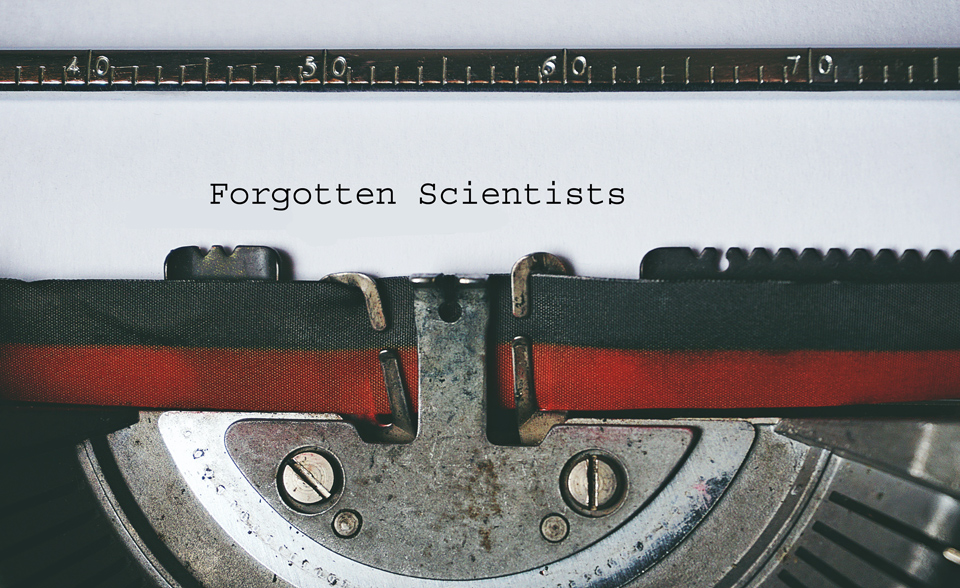You’ve probably heard the joke “What did Watson and Crick discover? Rosalind Franklin’s notes.”? Well, at the risk of party-pooperdom by picking apart a brilliant one-liner, the magic of the joke may just be in its bittersweet combination of comedy and tragedy. There: joke ruined. Yet it is quite possibly true: posthumously, Rosalind may have received some of the recognition she deserved to attain in her lifetime, but, for many, her legacy will always also be as an example of the injustices within the history of STEM.
History is littered with STEM heroes who may not have received the recognition they deserved, be it down to bad luck, bad timing or sheer injustice. However, the post of super STEM spin doctor; of special (press) agent to unfairly forgotten scientists is now available to us all. Who do you think deserves your efforts; who would you most like to represent? Perhaps you can think of someone already, or perhaps you could find someone new to you, too?
Ask yourself these questions:
- Who is most due a phoenix-like revival?
- Who deserves to have their profile raised and why?
- Does their work have particular relevance to the world today?
- Is their lack of fame a clear injustice that needs to be made right?
How will you convince the world that your client is worthy of remembrance; that they should no long slip under the radar? Could you use a poster, an animation, an essay or a well-thought out and tactically tip-top media campaign to raise their fame?
Take a look at a few examples of scientists below, or hunt out your own, and choose who you would represent as a super STEM press agent. Email us a focus@potentialplusuk.org with your suggestions.
How about…?
The Forgotten Scientists
- Maria Sibylla Merian (born 1647) – Entomologist and Scientific Illustrator.[i]
Maria Sibylla Merian was fascinated with butterflies at a time when the connection between caterpillars and butterflies was not properly understood. Publishing a book in 1679 on metamorphosis, which was not only scientifically thorough but beautifully illustrated, she did not stop there. Undertaking a big and brave adventure to Suriname’s rainforests, she documented newly discovered bugs and despite her trip being cut short due to her contracting malaria, she still had everything she needed to write The Metamorphosis of the Insects of Suriname, which was published in 1705 and was exceptionally well received across Europe.”[ii]
Beautiful illustrations, brave adventures to rainforests, catching malaria in the course of collecting her scientific data…how do we not know more about her today!? - Esther Lederberg (1922-2006) was a microbiologist who made great strides in the field of genetics research, developing techniques that assisted the understanding of how genes work. Her work assisted her husband Joshua’s Nobel prize win in 1958, but there was no mention of her in connection with the award.[iii] Would you like to right this wrong and represent her?
- Lise Meitner (1878-1968) was also not given the credit she was due for her scientific work. Though her work was instrumental in the discovery of nuclear fission, her longstanding collaborator, Otto Hahn did not cite Meitner when he published their findings, and it was Hahn alone who won the 1944 Nobel prize in Chemistry for his contribution to splitting the atom.[iv] Would you like to help make things right?
- Whilst Chien-Shiung Wu’s participation in the Manhattan Project and development of the atom bomb may be controversial – not just for the fact that she received very little credit for it – this was not her only contribution to science, nor her only exclusion from acclaim. Despite playing a key role in disproving the law of parity alongside Tsung-Dao Lee and Chen Ning Yang, she was left out of the 1957 Nobel Prize that celebrated this important moment in physics: it went only to Yang and Lee.[v] Could you raise her 21st century profile?
The Forgotten Inventors
- Charles Drew (1904-1950) Easily able to straddle all of these categories, Charles Drew was a physician, surgeon and medical researcher who also came up with ingenious methods to store, or “bank”, blood plasma, and headed up the “Blood for Britain” initiative during World War II. He also led a further initiative to develop a blood bank for the US military, but resigned in outrage at the military’s initial reluctance to use blood from African Americans at all, and their subsequent allowing for African-American blood to only be used for African-American soldiers. [vi]
- Gideon Sundback (1880-1954) – inventor of the zipper (originally called a “continuous clothing closure”!). It took a while for the invention to really take off (it was initially seen as too course-looking to be used for clothing), and so the creator has been somewhat forgotten in the long process of the zip attaining its now commonplace status.[vii]
- How about Noah and Joseph McVicker, inventors of Play-doh (patent issue in 1965)? Yes, it was invented by accident, and no, it is not as globally worthy as a vaccine or a wonder drug, but it has given children a lot of fun over the years![viii]
- Garrett Morgan (1877-1963), African-American inventor and great contributor to creations that make our world safer, should surely be better known, given that he invented, among other things, the first traffic signal system and also the first patented gas mask?[ix]
- Walter Hunt (born 1796), inventor of (among many other things) the safety pin? Such useful creations, but no awards and not much recognition, either in his own time or subsequently.[x]
- We certainly all know and use a version of his invention, but do we know the man himself? William Lyman, in 1870, created the first ever rotating wheel-style can opener? The fact that the tin needed to be pierced before his invention could be used meant that there was little enthusiasm for his creation in his time, so he died without much recognition for his achievement.[xi] Do you think this should now be changed?
- George de Mestral (1907-1990) – Inventor of Velcro
His invention was ridiculed at the time (seen as ugly and easily worn out), but it has ended up being a well-loved creation, especially with anyone too busy to bother with buttons and zips and the like![xii]
The Forgotten, Yet Magnificent, Multi-Talents
- How about…Hypatia – c.350/370-415…?
A mathematician, philosopher and astronomer with a mind multitalented enough to rival some of her much more famous (and male) counterparts[xiii]. - Wang Zhenyi (born 1768)
Born during the Qing dynasty and at a time when women were not expected to concern themselves with education, Wang Zhenyi was fortunate enough to have a family of scholars who were keen for her to be educated. Having been taught astronomy and maths by her father and grandfather, she had her own theories about the phenomenon of eclipses, which at the time were not well understood. She came up with an eclipse model using a globe, lamp and mirror: “Wang Zhenyi used it to prove her theories about how the Moon blocks our view of the sun – or the Earth blocks the Sun’s light from reaching the moon – during an eclipse.”
If that wasn’t enough, she was also a brilliant mathematician, publishing “Simple Principles of Calculation” at the tender age of 24, oh, and a poet, too, moved to writing about injustice after her extensive travels highlighted the awful ills of poverty.[xiv] How can we not know all about her already…?! - Benjamin Banneker (1731-1806)
Astronomer, mathematician, author and inventor of “America’s first functional clock”.[xv]
Not a bad curriculum vitae, especially given that he was mostly self-educated, having had a voracious appetite for reading as many borrowed books as he could get his hands on![xvi]
There are so many scientists, inventors and multi-talented people from the world of STEM who deserve to be better known. Whomever you choose to represent; whomever you decide deserves to be famous like Faraday or acclaimed like Einstein, enjoy raising their profiles and flying the flag for the forgotten STEM heroes!!
References
[i] Ignotofsky, (2016). R. Women in Science: 50 Fearless Pioneers who Changed the World. (p.11). Ten Speed Press
[ii] Ignotofsky, (2016). R. Women in Science: 50 Fearless Pioneers who Changed the World. (p.11). Ten Speed Press
[iii] https://www.bbc.co.uk/news/science-environment-33157396, The women whom science forgot, Jawad Iqbal
[iv] https://www.bbc.co.uk/news/science-environment-33157396, The women whom science forgot, Jawad Iqbal
[v] https://www.bbc.co.uk/news/science-environment-33157396, The women whom science forgot, Jawad Iqbal
[vi] https://www.famousscientists.org/15-famous-black-scientists-in-history/ https://www.biography.com/scientist/charles-drew
[vii] Jeff Mitchell, https://listverse.com/2013/05/13/10-under-appreciated-or-forgotten-inventors/
[viii] Jeff Mitchell, https://listverse.com/2013/05/13/10-under-appreciated-or-forgotten-inventors/
[ix] https://www.famousscientists.org/15-famous-black-scientists-in-history/ ; https://www.encyclopedia.com/people/history/historians-miscellaneous-biographies/garrett-morgan
[x] Jeff Mitchell, https://listverse.com/2013/05/13/10-under-appreciated-or-forgotten-inventors/
[xi] Jeff Mitchell, https://listverse.com/2013/05/13/10-under-appreciated-or-forgotten-inventors/
[xii] Jeff Mitchell, https://listverse.com/2013/05/13/10-under-appreciated-or-forgotten-inventors/
[xiii] Women in Science Ignotofsky, (2016). R. Women in Science: 50 Fearless Pioneers who Changed the World. (p.9). Ten Speed Press
[xiv] Ignotofsky, (2016). R. Women in Science: 50 Fearless Pioneers who Changed the World. (p.13). Ten Speed Press
[xv] https://www.britannica.com/biography/Benjamin-Banneker
[xvi] https://www.britannica.com/biography/Benjamin-Banneker
About the author: Caroline Hooton-Picard is an adviser for Potential Plus UK. She has a background in mental health, having worked for Suffolk Mind and also in private practice, and has a first class degree in Philosophy from the University of Essex. She also has a High Learning Potential daughter who keeps her very much on her toes!






